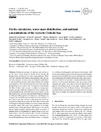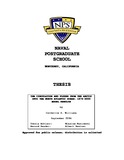On the Flow Through Bering Strait: A Synthesis of Model Results and Observations
| dc.contributor.author | Kinney, J. Clement | |
| dc.contributor.author | Maslowski, W. | |
| dc.contributor.author | Aksenov, Y. | |
| dc.contributor.author | de Cuevas, B. | |
| dc.contributor.author | Jakacki, J. | |
| dc.contributor.author | Nguyen, A. | |
| dc.contributor.author | Osinski, R. | |
| dc.contributor.author | Steele, M. | |
| dc.contributor.author | Woodgate, R.A. | |
| dc.contributor.author | Zhang, J. | |
| dc.date.accessioned | 2020-06-02T18:21:26Z | |
| dc.date.available | 2020-06-02T18:21:26Z | |
| dc.date.issued | 2014 | |
| dc.identifier.citation | Kinney, Jaclyn Clement, et al. "On the flow through Bering Strait: A synthesis of model results and observations." The Pacific Arctic Region. Springer, Dordrecht, 2014. 167-198. | en_US |
| dc.identifier.uri | https://hdl.handle.net/10945/64826 | |
| dc.description | The article of record as published may be found at https://link.springer.com/chapter/10.1007/978-94-017-8863-2_7 | en_US |
| dc.description.abstract | Bering Strait is the only ocean connection between the Pacific and the Arctic. The flow through this narrow and shallow strait links the Pacific and Arctic oceans and impacts oceanic conditions downstream in the Chukchi Sea and the Western Arctic. We present a model synthesis of exchanges through Bering Strait at monthly to decadal time scales, including results from coupled ice-ocean models and observations. Significant quantities of heat and freshwater are delivered annually into the southern Chukchi Sea via Bering Strait. We quantify seasonal signals, along with interannual variability, over the course of 26 years of multiple model integrations. Volume transport and property fluxes are evaluated among several high- resolution model runs and compared with available moored observations. High-resolution models represent the bathymetry better, and may have a more realistic representation of the flow through the strait, although in terms of fluxes and mean properties, this is not always the case. We conclude that, (i) while some of the models used for Arctic studies achieve the correct order of magnitude for fluxes of volume, heat and freshwater, and have significant correlations with observational results, there is still a need for improvement and (ii) higher spatial resolution is needed to resolve features such as the Alaska Coastal Current (ACC). At the same time, additional measurements with better spatial coverage are needed to minimize uncertainties in observed estimates and to constrain models. Bering Strait is the only ocean connection between the Pacific and the Arctic. The flow through this narrow and shallow strait links the Pacific and Arctic oceans and impacts oceanic conditions downstream in the Chukchi Sea and the Western Arctic. We present a model synthesis of exchanges through Bering Strait at monthly to decadal time scales, including results from coupled ice-ocean models and observations. Significant quantities of heat and freshwater are delivered annually into the southern Chukchi Sea via Bering Strait. We quantify seasonal signals, along with interannual variability, over the course of 26 years of multiple model integrations. Volume transport and property fluxes are evaluated among several high- resolution model runs and compared with available moored observations. High-resolution models represent the bathymetry better, and may have a more realistic representation of the flow through the strait, although in terms of fluxes and mean properties, this is not always the case. We conclude that, (i) while some of the models used for Arctic studies achieve the correct order of magnitude for fluxes of volume, heat and freshwater, and have significant correlations with observational results, there is still a need for improvement and (ii) higher spatial resolution is needed to resolve features such as the Alaska Coastal Current (ACC). At the same time, additional measurements with better spatial coverage are needed to minimize uncertainties in observed estimates and to constrain models. | en_US |
| dc.description.sponsorship | Department of Energy Earth System Modeling program (J. C. K and W. M.), National Science Foundation Office of Polar Programs (J. C. K, W. M., M. S., and J. Z.), and the Office of Naval Research (J. C. K and W. M.) for support of this research. We also thank the Arctic Ocean Model Intercomparison Project (J. C. K. and W. M.). At the National Oceanography Centre Southampton (Y.A. and B. d C.) the study was supported by the UK Natural Environment Research Council as a contribution to the Marine Centres’ Strategic Research Programme Oceans 2025. | en_US |
| dc.format.extent | 37 p. | en_US |
| dc.rights | This publication is a work of the U.S. Government as defined in Title 17, United States Code, Section 101. Copyright protection is not available for this work in the United States. | en_US |
| dc.title | On the Flow Through Bering Strait: A Synthesis of Model Results and Observations | en_US |
| dc.type | Book Chapter | en_US |
| dc.type | Preprint | en_US |
| dc.contributor.corporate | Naval Postgraduate School (U.S.) | en_US |
| dc.contributor.department | Oceanography | en_US |
| dc.subject.author | Bering Strait | en_US |
| dc.subject.author | Ocean modeling | en_US |
| dc.subject.author | Pacific water | en_US |
| dc.subject.author | Numerical modeling | en_US |
| dc.description.funder | Support for this work was provided (in part) by NSF grants ARC-0632154, ARC-0855748, and the NOAA-RUSALCA program (R. W.). The mooring data used in this study was collected under funding from ONR, NSF, MMS, AOOS and NOAA-RUSALCA (R. W). | en_US |





